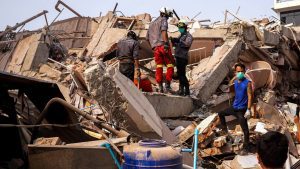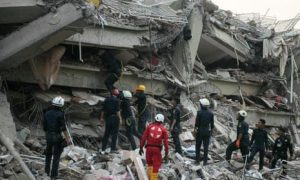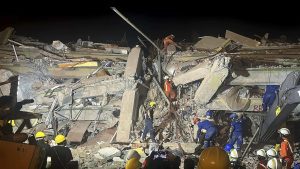A devastating 7.7-magnitude earthquake struck central Myanmar on March 28, 2025, causing widespread destruction and a rapidly rising death toll. As of March 31, official reports confirm that at least 2,056 people have lost their lives, while over 3,900 individuals are injured. Rescue efforts continue as emergency teams struggle to reach those trapped under debris.
Rising Casualties and Missing Persons
The Myanmar junta has declared a week of national mourning, with national flags to be flown at half-mast until April 6 as a mark of respect for the victims. Authorities have also confirmed that around 270 people remain missing, and the actual death toll is expected to rise further as search operations progress.
The earthquake, which struck near Mandalay, Myanmar’s second-largest city, caused widespread devastation, destroying buildings, roads, and bridges. The disaster has not only impacted Myanmar but also affected neighboring countries, including Thailand, China, Vietnam, and parts of India.

Mandalay Faces the Worst Impact
Mandalay, home to more than 1.7 million residents, has been the most severely affected city. Entire neighborhoods have been reduced to rubble, leaving thousands homeless. Rescue workers are facing difficulties due to blocked roads, damaged infrastructure, and limited resources.
According to reports, hospitals in the city are overwhelmed with injured survivors, while makeshift shelters have been set up for those displaced. “The situation is so dire that it’s hard to describe what is happening here,” said Aung Myint Hussein, chief administrator of Mandalay’s Sajja North mosque. “People are desperate for food, water, and medical assistance.”
People Camp Out in the Streets Amid Aftershocks
Residents of Mandalay and other affected areas are reluctant to return to their homes due to ongoing aftershocks. Many have been forced to spend nights outdoors, fearing that weakened buildings may collapse. While some have managed to set up makeshift tents, others—including young children—are sleeping on blankets laid out in the streets.
One resident, Kyaw Min Tun, shared his experience: “We have nowhere to go. Our house is gone, and it’s too dangerous to stay near buildings. My family and I are sleeping under the open sky, hoping for help to arrive soon.”
Foreign Casualties and Regional Effects
The earthquake’s impact was felt beyond Myanmar’s borders. Reports confirm that three Chinese nationals and two French citizens lost their lives in the disaster.
In Bangkok, Thailand’s capital, at least 19 people were killed when a 30-story building under construction collapsed due to the quake’s tremors. Authorities in Thailand, Vietnam, and India have issued advisories and are monitoring the situation closely.


Rescue Efforts and Challenges
Rescue operations are ongoing, with emergency teams racing against time to find survivors. However, the response is being hampered by damaged infrastructure, lack of heavy machinery, and limited access to remote areas.
International organizations, including the United Nations and the Red Cross, have pledged assistance. Myanmar has received aid offers from China, Russia, India, and the United States. However, delivering aid has proven difficult due to the country’s ongoing civil conflict since the military coup in 2021. Humanitarian organizations fear that political instability may further complicate relief efforts and the fair distribution of aid.
Hospitals Overwhelmed, Shortage of Medical Supplies
With thousands of injured survivors needing medical attention, hospitals and clinics are struggling to cope. Reports indicate a severe shortage of medical supplies, beds, and healthcare workers. The World Health Organization (WHO) has already dispatched nearly three tons of medical supplies to the region and plans to send additional shipments.
Doctors Without Borders (MSF) has also deployed emergency response teams to help treat the injured. “The medical needs are enormous,” said a spokesperson from MSF. “We need urgent international assistance to prevent further loss of life.”


Humanitarian Crisis and Global Response
The earthquake has intensified Myanmar’s already fragile humanitarian situation. Before the disaster, the country was already dealing with internal displacement due to conflict. The quake has now left tens of thousands more homeless, with limited access to food, clean water, and electricity.
The international community has begun mobilizing aid to assist those affected. Several countries have pledged donations and relief supplies. Non-governmental organizations (NGOs) are also stepping in to provide food, temporary shelter, and medical aid.
The United Nations has called for urgent global support to help Myanmar recover from this tragedy. “This is one of the worst disasters to hit the region in recent years. We must act swiftly to provide humanitarian relief to those in need,” stated UN Secretary-General António Guterres.
The Road to Recovery
As Myanmar deals with the aftermath of the earthquake, the focus now shifts to recovery and rebuilding. Experts warn that it could take years for the country to fully recover from the disaster.
Engineers and structural specialists are assessing damage to buildings and infrastructure, determining which areas are safe for people to return to. Meanwhile, authorities are working on plans for long-term rehabilitation, including housing and livelihood support for displaced families.
The resilience of the people of Myanmar will be crucial in overcoming this tragedy. International support, effective disaster response, and long-term rebuilding strategies will play a key role in helping affected communities get back on their feet.
Also Read : Tragic Landslide Near Manikaran Gurudwara in Kullu Claims Six Lives and Several Injured
The 7.7-magnitude earthquake in Myanmar has resulted in an immense loss of life and widespread destruction. With over 2,000 confirmed deaths and thousands injured, the disaster has left a deep impact on the region. As rescue and relief operations continue, the true scale of the catastrophe is still unfolding. The international community’s support remains vital in addressing immediate needs and ensuring a sustainable recovery for Myanmar’s affected regions.

